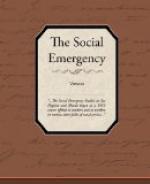The public skating-rink is fairly free from objectionable features, but boys and girls attending without proper chaperons often form undesirable acquaintances. Women of the street and their male companions often attend. Juvenile court officials are aware of the immoralities springing from this source.
The amusement parks present almost unlimited possibilities for the formation of undesirable acquaintances. The fact that they are open in the evening, and not lighted in all parts, the presence of cafes where liquors can be had, inadequate police protection, the secrecy possible through the presence of large crowds, the size of the parks, the distance from the homes in the city, and the unchaperoned attendance of large crowds of young people, all make amusement parks dangerous without closer supervision by public authorities.
In former days the road-house ministered to the legitimate needs of wayfaring travelers. To-day the name “road-house” is synonymous with the “bawdy-house” of the city. Located just beyond the borders of towns and cities, beyond police supervision, catering to men and women who desire secrecy for their revels and orgies, the road-house is one of the worst possible institutions now ministering to the leisure time of the people.
In some sections of this country, the public excursion, both by land and water, is as bad as the road-house. Instead of being a time of relaxation and recreation, a time of freedom from cares of the workaday life and enjoyment of pure air, sunshine, and beauties of nature, and of fine social relationships of people, the excursions have become dissipations of physical and moral energy. With proper supervision and with proper standards on the part of promoters of transportation companies, the public excursion can be a fine constructive factor in the use of the leisure time of the people.
Festivals and carnivals conducted by the people of a community, commemorative of national holidays or of historical events or of religious life, are often admirable. But whenever the festival or carnival becomes a commercial enterprise for the purpose of attracting crowds to the city, for advertisement and for gain by merchants and hotel proprietors, young people are in danger. The city becomes the mecca for undesirable men and women who prey upon the susceptibilities of the people, animated by the festival spirit. The hotels are the temporary homes of women of the street. Every large festival of this kind has been followed by social evils of the most virulent type. Many a girl and many a boy, yielding to the influences of the abandonment of the crowd, take the first step in sexual vice. This type of festival is not socially profitable to a community, where the commercial aim and purpose predominates. The commercial exploitation of the recreation and social needs of the people is usually productive of sexual immorality.
A characteristic feature of American life is the club, union, society, or order spontaneously formed by the people. No matter what the fundamental purposes of these groups may be, whether for protection against sickness, accident, and industrial evils, whether for the study of art, music, and literature, or for the promotion of physical activities, the primary bond that brings the group together and holds it together is the social instinct of mankind.




